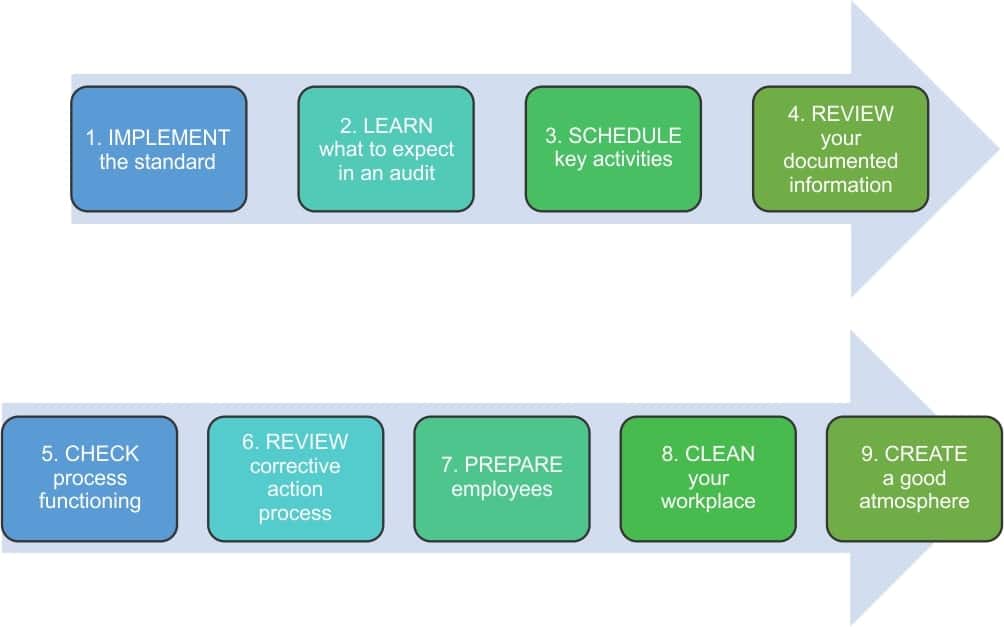 Iciar Gallo
Iciar Gallo
February 12, 2019
Before an organization gets involved in the ISO 14001 certification audit process, many people are concerned about how to be prepared for this final step of becoming compliant. The truth is that having an auditor checking your work usually creates some tension and fear among many employees, even if it is not their first time going through a certification audit. Which issues should you consider and what should you expect during the preparation for ISO 14001 certification audit? Learn about it in this article.
Writing the required documented information and setting up of processes of your environmental management system should be the first step taken with a view to obtaining the ISO 14001 certification. After finishing these activities of implementation and operation, you should perform an internal audit to check the effective implementation, conduct a management review and carry out the necessary corrective actions in order to comply with all clauses in the standard.
Auditors won’t be able to review every process so they will select a sample and test just one or two aspects to ensure the proper operation of the system.
Usually certification audits consist of two different stages. In stage 1, auditors will review documented information of your organization before visiting the facilities to check whether it is compliant with ISO 14001. They often perform an onsite audit to obtain confirmation that basic documented information, like manuals and mandatory procedures, are in place. In stage 2, auditors will check if activities are compliant with ISO 14001. They will gather audit evidence based on observations, interviews and examination of documented information.
You need to establish a schedule for every activity, including internal audit and management review, ensuring you will have enough time to perform and complete every phase of the project correctly, without rushing at the end. A good way to do it is writing a Project Plan at the beginning of the implementation. This lets you set the milestones for the different tasks and assign responsibilities.
Ensure you have updated all your documented information, and that nobody in the organization uses obsolete documentation. On the other hand, it is important that all employees conducting an activity should follow documents that have been reviewed and approved as well as communicated.

It seems too obvious, but some people forget about this step when performing testing in the organization before the certification audit takes place. Ensuring all procedures are being followed and processes are conducted as the organization has previously planned is critical for a successful certification audit.
Check that all non-conformities have been recorded and analyzed, and corrective actions have been effectively carried out and that corrections end before the certification audit takes place. It is also recommended that you review previous internal and external audits to make sure findings have been addressed.
All employees within the organization need to understand the environmental policy of the organization in order to learn what their commitments are in relation to environment protection. In addition, employees should be aware of the environmental objectives, so they can contribute toward achieving them with their daily activities.
Make sure you calm down the employees before the certification audit, explaining they shouldn’t be afraid of the auditor. Ultimately, the auditor’s role is not finding any mistakes but assuring that everything has been carried out as the organization has planned. Using these kinds of arguments, employees should feel confident when answering auditor questions.
Training is a requirement of the standard but also must be part of this preparation, that is, every employee should be able to conduct their work properly.
Everything should be in right place, so take your time organizing your desk, office, warehouse, etc. This will ensure that relevant documentation, including policies, procedures, work instructions, records and others are easy to find if the auditor asks for them.
Last but not least, look at the auditor from a positive perspective – as previously mentioned, get rid of the fear. Auditors will help you to improve your organization and their processes. Creating a professional and relaxed atmosphere will help employees to get rid of their fear but also to benefit from a smooth audit process.
Following these steps and dedicating enough time and effort to each of them will ensure your organization has a smooth and successful certification audit without any last-minute surprises, so read the 9 steps carefully and start carrying them out. The sooner the better!
To learn more about implementation steps leading towards ISO 14001 certification, check this free online training ISO 14001:2015 Foundations Course.